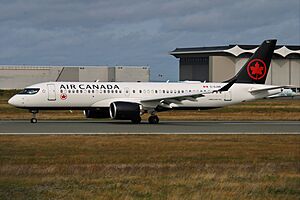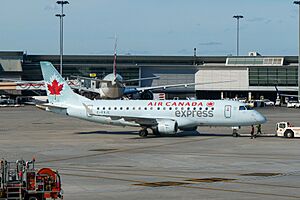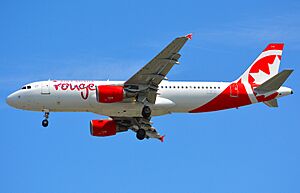Air Canada facts for kids
An Air Canada Boeing 787-9
|
|
| Founded | 10 April 1937 as Trans-Canada Air Lines |
|---|---|
| Commenced operations | 1 January 1965 as Air Canada |
| AOC # |
|
| Hubs | |
| Focus cities |
|
| Frequent-flyer program | Aeroplan |
| Alliance | Star Alliance |
| Subsidiaries |
|
| Fleet size | 353 (including subsidiaries) |
| Destinations | 192 |
| Headquarters | Saint-Laurent, Quebec, Canada |
| Key people | |
| Revenue | |
| Operating income | |
| Net income | |
| Total assets | |
| Employees | 35,700(2023) |
Air Canada is Canada's biggest airline. It is known as the country's flag carrier, meaning it represents Canada around the world. Air Canada's main office is in Montreal, Quebec.
The airline started in 1937. It offers flights for people and cargo to many places worldwide. Its main travel hubs are in Montreal, Toronto, and Vancouver. Air Canada is also a founding member of the Star Alliance, which is a big group of airlines that work together.
Canada's government created the airline in 1936. It was first called Trans-Canada Air Lines (TCA). TCA started flying across Canada in 1938. In 1965, the name changed to Air Canada. The airline became a private company in 1988. In 2000, Air Canada took over its biggest competitor, Canadian Airlines. In 2003, the airline faced financial problems but got back on track the next year. In 2019, Air Canada flew over 51 million passengers. In 2021, the Canadian government bought a small part of Air Canada to help it during the COVID-19 pandemic.
Air Canada uses different types of planes. Large planes like the Airbus A330, Boeing 777, and Boeing 787 Dreamliner are used for long flights. Smaller planes like the Airbus A320 family, Boeing 737 MAX 8, and Airbus A220-300 are used for shorter trips. Air Canada also has special divisions. These include Air Canada Cargo for shipping goods, Air Canada Express for regional flights, Air Canada Jetz for private charters, and Air Canada Rouge for vacation travel. Air Canada Vacations also offers holiday packages. Together with its partners, the airline flies more than 1,600 scheduled flights every day.
Contents
- Air Canada's Story
- How Air Canada Works
- Where Air Canada Flies
- What It's Like to Fly Air Canada
- Aeroplan: Air Canada's Loyalty Program
- Plane Incidents
- More About Air Canada
- See also
Air Canada's Story
Starting as Trans-Canada Air Lines (1937–1965)
Air Canada began as Trans-Canada Air Lines (TCA) on April 11, 1937. It was part of the Canadian National Railway. The government wanted an airline to connect cities across Canada. They bought two Lockheed Model 10 Electra planes and one Boeing Stearman biplane. They also hired experienced airline leaders.
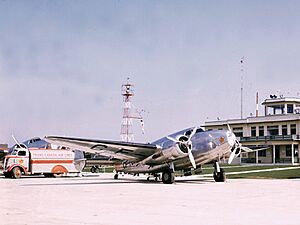
Passenger flights started on September 1, 1937. The first flight carried two passengers and mail from Vancouver to Seattle. On July 1, 1938, TCA hired its first flight attendants. Flights across Canada, from Montreal to Vancouver, began on April 1, 1939. By January 1940, the airline had about 579 employees.
In 1942, another airline, Canadian Pacific Airlines (CP Air), suggested joining with TCA. But the Prime Minister said no. He made a rule that TCA was the only airline allowed to fly across Canada. After World War II, CP Air was allowed to have one cross-Canada flight and some international routes.
TCA's main office was first in Winnipeg. In 1949, the government moved it to Montreal. In 1953, TCA was the first airline to use a computer system for booking flights.
Becoming Air Canada (1965–1990)
By 1964, TCA was Canada's national airline. In 1965, its name officially changed to Air Canada. This was a name TCA had already used in French for a long time. Elizabeth II, the Queen of Canada, flew on the first plane with the new Air Canada name and look in 1964.
In the 1970s, government rules helped Air Canada stay the main airline. Smaller airlines could not compete directly with Air Canada. Air Canada's ticket prices were also set by the government.
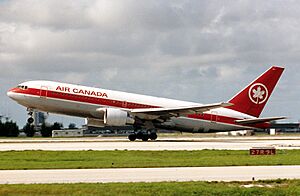
In 1976, Air Canada became an independent company owned by the government. New rules in 1978 allowed Air Canada to compete more fairly. The government stopped controlling its routes and prices directly. In 1987, new laws opened up the airline market in Canada to more competition. Air Canada bought new planes like the Boeing 727, Boeing 747, and Lockheed Tristar. In 1978, Judy Cameron became the first female pilot hired by a major Canadian airline, flying for Air Canada.
By 1985, Air Canada needed more money to update its planes. So, in 1988, the government sold part of Air Canada to the public. By 1989, Air Canada was fully owned by private investors. On December 7, 1987, Air Canada was the first airline in the world to ban smoking on all its flights.
Changes and Growth (1990s)
In the early 1990s, Air Canada faced money problems after the Gulf War. To fix this, the airline changed its leadership. They hired Hollis L. Harris as CEO. He reorganized the airline, cut management jobs, and sold some parts of the business. By 1994, Air Canada was making a profit again. That same year, it gained permission to fly to the new Kansai International Airport in Japan.
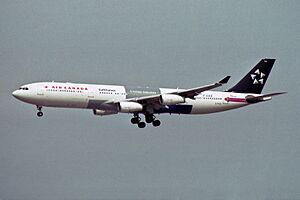
In 1995, Air Canada added 30 new routes to the US. This was possible because of a new agreement between the US and Canada. In May 1997, Air Canada helped start the Star Alliance. This group allows airlines to work together, sharing flights and benefits. In the late 1990s, Air Canada made good profits.
In September 1998, Air Canada pilots went on strike for the first time, asking for better pay. In 1999, the Canadian government changed some rules to help Canadian airlines combine. Other companies tried to buy Canadian Airlines, a rival. This led Air Canada to make its own offer to buy Canadian Airlines.
Joining Forces and Reorganizing (2000s)
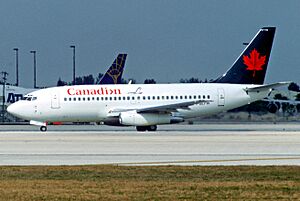
In January 2000, Air Canada bought Canadian Airlines International, which was Canada's second-largest airline. This made Air Canada one of the biggest airlines in the world. But Air Canada soon found out that Canadian Airlines was in worse financial shape than they thought. They tried to merge the two airlines quickly. This caused flight delays and luggage problems in summer 2000. Service improved by January 2001. However, the airline faced more challenges with a global airline slowdown. It lost money in 2001 and 2002.
Financial Challenges and Recovery
Because of its financial difficulties, Air Canada had to seek protection from its creditors on April 1, 2003. It came out of this protection on September 30, 2004, after 18 months. During this time, different companies tried to invest in Air Canada. Finally, Deutsche Bank offered a large financial package. This deal was accepted after Air Canada agreed to cut costs.
A new parent company, ACE Aviation Holdings, was created for the reorganized Air Canada. In October 2004, Canadian singer Celine Dion became the public face of Air Canada. She recorded her song "You and I" for Air Canada commercials.
Updating the Fleet
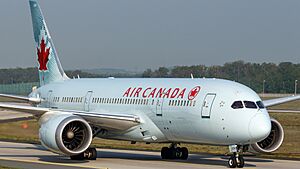
On October 31, 2004, the last Air Canada Boeing 747 flight landed. This ended 33 years of 747 service for the airline. The 747s were replaced by Airbus A340 planes. On October 19, 2004, Air Canada showed off new plane colors and uniforms. The new design featured a silver-blue color and a new version of the maple leaf logo, called the 'Frosted Leaf'.
On November 9, 2005, Air Canada decided to buy 16 Boeing 777s and 14 Boeing 787-8s. They also had options to buy more. The 777s started arriving in March 2007, and the 787s began arriving in May 2014.
Project XM: Extreme Makeover
In July 2006, Air Canada started "Project XM: Extreme Makeover." This was a $300 million project to update the inside of all its planes. New planes like the Boeing 777 already had these new features. Some of the new features included:
- New flat beds in Executive First class on larger planes.
- New seats in all classes with new entertainment options.
- Personal screens for movies and games in Economy and Executive Class.
- Larger screens with noise-cancelling headphones in Executive First Suites.
- Games and XM Radio Canada at every seat.
- USB ports and power outlets to charge electronic devices.
Financial Challenges in the Late 2000s
High fuel prices and a big economic slowdown caused problems for Air Canada in the late 2000s. In June 2008, the airline announced it would lay off over 2,000 employees. It also planned to reduce its number of flights.
Montie Brewer, the CEO, left in March 2009. Calin Rovinescu took over on April 1. Air Canada also had a large pension shortfall. The company needed new funding and help with its pension payments. In July 2009, Air Canada received about CA$1 billion in financial help from different groups, including the Canadian government.
The 2010s
In December 2010, ACE, the parent company, sold some of its Air Canada shares. It sold the rest in November 2012.
New Look and Planes
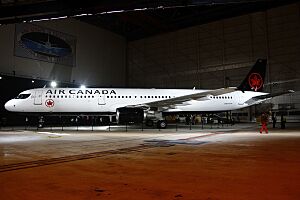
On February 9, 2017, Air Canada launched a new red and black look for its planes. This was to celebrate Air Canada's 80th birthday and Canada's 150th anniversary. The new design includes parts of the old logo from 1964 to 1992. It has a white body, a black underside, a tail with a red maple leaf, and black "Air Canada" letters.
In December 2013, Air Canada ordered 61 Boeing 737 MAX planes. These were to replace its older Airbus A320 planes. The first MAX 8 plane arrived on November 2, 2017. Some older Airbus A319s were moved to Air Canada's Rouge airline. Air Canada also made a deal with Bombardier Aerospace to get Airbus A220/CSeries planes starting in 2019.
In July 2017, Air Canada brought back Premium Economy on its wide-body flights in North America.
In April 2018, Air Canada renamed its international business class as Air Canada Signature Class. This class offers better food, new travel kits, and a special car service at its main hubs. It also gives access to the Air Canada Signature Suite at Toronto Pearson International Airport.
In May 2018, Air Canada listed Taiwan as part of China to follow a rule from China's aviation authority. On June 6, 2018, Air Canada and Air China started a joint venture. This was the first time a North American and Chinese airline worked together in this way.
Planned Purchase of Transat A.T.
On May 16, 2019, Air Canada announced it was talking about buying Transat A.T., the company that owns Air Transat. On June 27, 2019, Transat A.T. agreed to be bought by Air Canada. Air Canada increased its offer on August 11, 2019. Most Transat A.T. shareholders approved the deal on August 23, 2019. The price was lowered in October 2020 because of the COVID-19 pandemic.
The Canadian government approved the takeover on February 11, 2021. However, the deal was canceled in April 2021 because it did not get approval from the European Commission.
The 2020s
COVID-19 Pandemic Impact
Travel restrictions during the COVID-19 pandemic made Air Canada greatly reduce its flights. On March 18, 2020, the airline said it would stop most flights by March 31. Flights slowly started to return to normal on May 22. Air Canada lost a lot of money in 2020 due to the pandemic.
In April 2021, the Government of Canada bought a small part of Air Canada. This was part of a large financial aid package to help the airline during the pandemic.
In September 2022, Air Canada welcomed the government's decision to remove remaining COVID-19 rules. These included mask rules on planes, testing, and quarantine. The airline noted that these rules were no longer needed based on science.
How Air Canada Works
Business Performance
Air Canada lost money for several years but started making a profit in 2012. However, because of the COVID-19 pandemic, the company lost money again in 2020, 2021, and 2022. In 2023, Air Canada returned to profitability.
Ownership
Air Canada became a fully private company in 1989. Its shares are traded on the Toronto Stock Exchange. As of April 2021, the Government of Canada owns about 6.4% of Air Canada.
Rules in Canada limit how much of Air Canada can be owned by people who are not Canadian. This helps make sure that Canadian airlines are mostly owned and controlled by Canadians.
Leaders of Air Canada
Before 1976, Air Canada was part of the Canadian National Railway. Since 1976, these people have been the CEO and President:
- 1976–1984: Claude Taylor
- 1984–1990: Pierre Jeanniot
- 1990–1992: Claude Taylor
- 1992–1996: Hollis L. Harris
- 1996–1999: R. Lamar Durrett
- 1999–2004: Robert Milton
- 2004–2009: Montie Brewer
- 2009–February 2021: Calin Rovinescu
- February 2021–present: Michael Rousseau
Main Office and Operations
By Canadian law, Air Canada must keep its main office in Montreal. Its corporate headquarters is called Air Canada Centre. It is a 7-story building at Montréal–Trudeau International Airport in Saint-Laurent.
In 1990, the airline moved its headquarters to the airport to save money.
Air Canada's Operations Centre is in Brampton, Ontario. This center manages all flight operations, including scheduling crews and flights.
Air Canada's Other Businesses
Air Canada Cargo
Air Canada Cargo is the part of the company that carries freight. It is based at Toronto-Pearson Airport. It ships goods to over 150 places using Air Canada's planes and ground transport. It focuses on destinations in Europe and also flies directly from Vancouver and Calgary to major European cities.
In Toronto, a new cargo terminal was finished in 2002. It has modern systems for tracking and moving goods. There are also cargo terminals in Vancouver, Calgary, and Montreal.
Air Canada Express
Air Canada Express is the name for Air Canada's regional flights. These flights are operated by other airlines like Jazz Aviation and PAL Airlines.
Air Canada Jetz
Air Canada Jetz started in 2002. It is a special charter service for sports teams, entertainers, and companies. Air Canada Jetz uses Airbus A319 and A320 planes that have only business class seats. In 2015, Air Canada agreed to provide charter services for several NHL teams again.
Air Canada Rouge
Air Canada Rouge started in December 2012. It is an airline owned by Air Canada. Air Canada Rouge mainly flies to vacation spots in Europe, the Caribbean, South America, Central America, Mexico, and the United States. It uses Airbus A319, Airbus A320, and Airbus A321 planes.
Air Canada Vacations
Air Canada Vacations is Air Canada's tour company. It offers vacation packages that include hotels, Aeroplan Miles, and roundtrip flights on Air Canada or its partners.
Air Canada Vacations offers Executive Class service on some flights. It also has direct flights from major Canadian cities to many destinations.
Aeroplan
Aeroplan is Air Canada's loyalty program. You can collect points and use them for flights and other rewards. Air Canada bought Aeroplan back in January 2019.
Past Businesses
Air Canada Jazz
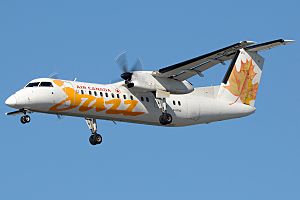
In 2001, Air Canada combined its regional airlines into one company called Air Canada Regional Incorporated. In 2002, this became Air Canada Jazz. Air Canada Jazz became an independent company in 2006. The "Air Canada Jazz" name was used for regional flights until 2011. Now, all regional flights use the "Air Canada Express" name. Jazz Aviation is the largest of these partners.
Air Canada Tango
On November 1, 2001, Air Canada launched Air Canada Tango. This service offered simpler, lower-cost flights using 13 Airbus A320 planes. These planes had only economy seats. Tango flew to many cities in Canada and some in the US. It was meant to compete with other low-cost airlines. The Tango service ended in 2004. Air Canada used to call its lowest fare class "Tango." As of 2018, this fare class is called "Standard fare."
Zip
In 2002, Air Canada started a discount airline called Zip. It was created to compete with WestJet in Western Canada. Zip used Boeing 737-200 planes and had its own staff. It stopped operating in 2004.
Where Air Canada Flies
Main Hubs
Air Canada has three main hubs:
- Toronto–Pearson: This is Air Canada's main global hub.
- Montréal–Trudeau: This is a second hub for Eastern Canada and a main gateway to French and other international places.
- Vancouver: This is a second hub for Western Canada and the main gateway to Asia and the Pacific.
Destinations
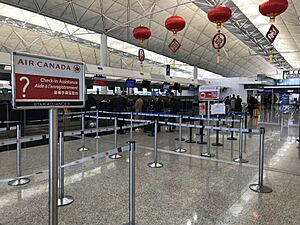
As of January 2024, Air Canada flies to 64 places within Canada and 158 international places. These include destinations in Asia, Africa, the Americas, Europe, and Oceania. With its regional partners, Air Canada serves over 222 destinations in 47 countries across six continents.
Air Canada also has special "fifth freedom" flights. These are flights where the airline can pick up and drop off passengers between two non-Canadian cities. For example, it flies from São Paulo to Buenos Aires and from London Heathrow to Delhi.
Airlines Air Canada Works With
Air Canada works closely with many other airlines. This means you can often book a flight with Air Canada that is actually flown by one of its partners. This is called a codeshare agreement.
- Aegean Airlines
- Aer Lingus
- airBaltic
- Air China
- Air Dolomiti
- Air India
- Air New Zealand
- All Nippon Airways
- Asiana Airlines
- Austrian Airlines
- Avianca
- Azul Brazilian Airlines
- Brussels Airlines
- Cathay Pacific
- Central Mountain Air
- Croatia Airlines
- Discover Airlines
- Edelweiss Air
- Egyptair
- Emirates
- Ethiopian Airlines
- Etihad Airways
- Eurowings
- EVA Air
- Flydubai
- Gol Linhas Aéreas Inteligentes
- ITA Airways
- LOT Polish Airlines
- Lufthansa
- Middle East Airlines
- Scoot
- Singapore Airlines
- SriLankan Airlines
- Swiss International Air Lines
- TAP Air Portugal
- Thai Airways International
- Turkish Airlines
- United Airlines
- Virgin Australia
Air Canada also has agreements with many other airlines to help passengers connect between flights. This is called an interline agreement.
- Aer Lingus
- Aegean Airlines
- Aerolíneas Argentinas
- Aeroméxico
- Air Algérie
- airBaltic
- Air Calédonie
- Air China
- Air Creebec
- Air Dolomiti
- Air France
- Air India
- Air Mauritius
- Air New Zealand
- Air Serbia
- Air Tahiti Nui
- Alaska Airlines
- All Nippon Airways
- American Airlines
- Asiana Airlines
- Austrian Airlines
- Avianca
- Avianca Costa Rica
- Avianca Ecuador
- Avianca El Salvador
- Azul Brazilian Airlines
- Bamboo Airways
- Bearskin Airlines
- Biman Bangladesh Airlines
- British Airways
- Brussels Airlines
- Canadian North
- Caribbean Airlines
- Cathay Pacific
- Cayman Airways
- Central Mountain Air
- China Airlines
- China Eastern Airlines
- China Southern Airlines
- Copa Airlines
- Croatia Airlines
- Delta Air Lines
- Edelweiss Air
- Egyptair
- Emirates
- Ethiopian Airlines
- Etihad Airways
- Eurowings
- EVA Air
- Fiji Airways
- Garuda Indonesia
- Gol Linhas Aéreas Inteligentes
- Gulf Air
- Hawaiian Airlines
- Hong Kong Airlines
- Iberia
- Icelandair
- Japan Airlines
- Jeju Air
- Jetstar
- Jetstar Asia Airways
- Jetstar Japan
- Juneyao Airlines
- Kenya Airways
- KLM
- Korean Air
- Kuwait Airways
- LATAM Airlines Group
- LIAT
- LOT Polish Airlines
- Lufthansa
- Luxair
- Malaysia Airlines
- Olympic Air
- Oman Air
- Pakistan International Airlines
- Pascan Aviation
- Philippine Airlines
- PAL Airlines
- Qatar Airways
- Qantas
- Royal Air Maroc
- Royal Jordanian
- Saudia
- Scandinavian Airlines
- Shenzhen Airlines
- Singapore Airlines
- South African Airways
- SriLankan Airlines
- Swiss International Air Lines
- TAP Air Portugal
- Thai Airways International
- Tunisair
- Turkish Airlines
- Ukraine International Airlines
- United Airlines
- Vietnam Airlines
- Virgin Atlantic
- Virgin Australia
- Widerøe
What It's Like to Fly Air Canada
Air Canada offers three types of service: Business/Signature, Premium Economy, and Economy. On most long international flights and some shorter ones, you can choose from Signature Class, Premium Economy, or Economy. For most short and domestic flights, there are Business Class and Economy Class.
All main Air Canada planes have screens for movies and TV shows. They also have special lighting. Air Canada Express planes have Business Class and Economy Class on some aircraft. All main planes and some Air Canada Express planes have Wi-Fi.
Starting in 2025, Air Canada will offer fast and free Wi-Fi to Aeroplan members on most flights within North America, Mexico, and the Caribbean. They plan to add this to international flights starting in 2026.
In 1987, Air Canada tried out no-smoking flights between Canada and New York City. After a survey showed that most passengers liked it, Air Canada banned smoking on more flights.
Flight Attendant Uniforms
On February 9, 2017, Air Canada showed off new uniforms for its cabin crew. This was part of the airline's 80th anniversary. Canadian fashion designer Christopher Bates created the new uniforms. They are mostly black or grey with red letters and the famous maple leaf.
Between 2004 and 2017, Air Canada uniforms were a dark blue color. Canadian fashion designer Debbie Shuchat designed those uniforms.
Aeroplan: Air Canada's Loyalty Program
Aeroplan is Air Canada's program for loyal customers. You can earn points when you fly or use certain credit cards. Then, you can use these points for flights, upgrades, or other rewards.
In May 2017, Air Canada announced it would create a new loyalty program. On January 10, 2019, Air Canada bought Aeroplan back. In 2020, Air Canada's old status program, Altitude, joined with Aeroplan. Now, Aeroplan is the main program for earning status and rewards.
Aeroplan Elite Status
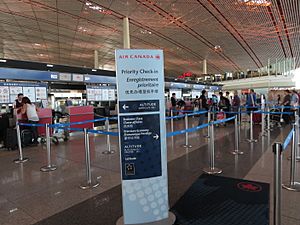
On September 20, 2012, Air Canada launched "Air Canada Altitude." This program gave special status levels to frequent flyers. Aeroplan was still for collecting and spending miles. Altitude was for getting special benefits based on how much you flew.
There are different levels of membership in Aeroplan Elite Status: Basic, Prestige 25K, Elite 35K, Elite 50K, Elite 75K, and Super Elite 100K. The higher levels offer benefits like upgrades, access to airport lounges, and priority services (like faster check-in and luggage handling). To reach these levels, you need to fly a certain number of miles or segments and spend a certain amount of money.
Prestige and Elite 35K members get Star Alliance Silver status. Elite 50K, Elite 75K, and Super Elite 100K members get Star Alliance Gold status. This means they get benefits when flying with other airlines in the Star Alliance group.
Your status is calculated each year. If you reach a higher status, you get those benefits for the rest of the current year and all of the next year.
On November 8, 2020, Air Canada Altitude changed its name to Aeroplan Elite Status. The ways you earn status (miles, segments, and dollars) also got new names.
Plane Incidents
Air Canada has had some incidents over the years. Here are a few notable ones:
| Date | Flight number | Description | |
|---|---|---|---|
|
|
|
A Vickers Viscount plane was badly damaged when it crash-landed at Toronto Airport. Two engines failed during landing. | |
|
|
|
A McDonnell Douglas DC-8 crashed and burned during a training flight in Ottawa. All three crew members died. | |
|
|
|
A Vickers Viscount was hijacked by a passenger who wanted the plane to go to Cuba. The plane landed safely in Montreal, and no one was hurt. This was the first hijacking in Canadian history. | |
|
|
|
A Vickers Viscount was damaged by a fire during takeoff from Sept-Îles Airport. One passenger died in the fire. | |
|
|
|
A Vickers Viscount crashed into a small plane near Vancouver International Airport. The pilot of the small plane died. | |
|
|
|
A McDonnell Douglas DC-8 exploded in Toronto during a landing attempt. All 109 people on board died. | |
|
|
|
A McDonnell Douglas DC-8 caught fire while being refueled at Toronto Pearson International Airport. No one died. | |
|
|
|
A McDonnell Douglas DC-9 went off the runway in Toronto after a tire burst during takeoff. Two of the 107 people on board died. | |
|
|
|
A McDonnell Douglas DC-9 had its tail section break off during a flight from Boston. A large hole appeared in the back of the plane. No one died, and the plane landed safely. | |
|
|
|
A McDonnell Douglas DC-9 had an electrical fire in the bathroom during a flight. It made an emergency landing in Cincinnati. During the evacuation, a sudden fire spread through the cabin, killing 23 of the 41 passengers. All five crew members survived. This is Air Canada's most recent accident with deaths. | |
|
|
|
A Boeing 767-200 ran out of fuel high above Red Lake, Ontario. The pilots managed to glide the plane to an emergency landing in Gimli. Some people had minor injuries during the evacuation. This event was featured in a TV movie and a book. | |
|
|
|
An Air Canada flight crashed during a landing attempt in Fredericton, New Brunswick, in bad weather. Nine people were seriously hurt. | |
|
|
|
An Airbus A320 from Toronto crashed short of the runway in Halifax during a severe winter storm. It hit approach lights and power lines, causing a power outage at the airport. All 133 passengers and five crew members survived, but 23 people went to the hospital with minor injuries. The plane was too damaged to be used again. | |
|
|
|
An Air Canada flight from Toronto to San Francisco almost landed on a taxiway where four other planes were waiting. A retired pilot said this near-miss was "probably close to the greatest aviation disaster in history" because of the risk to over 1,000 passengers. |
More About Air Canada
- ACE Aviation Holdings
- Air Canada Rouge
- Chorus Aviation
- Jazz Aviation LP
- List of airlines of Canada
- List of airports in Canada
- List of companies of Canada
- Air Transat
- Transportation in Canada
- Air transport in Canada
See also
 In Spanish: Air Canada para niños
In Spanish: Air Canada para niños



